HIV AIDS epidemiology and demographics: Difference between revisions
Sergekorjian (talk | contribs) (→Age) |
Mohamed riad (talk | contribs) |
||
| (86 intermediate revisions by 9 users not shown) | |||
| Line 2: | Line 2: | ||
{{AIDS}} | {{AIDS}} | ||
{{CMG}} ; {{AE}} {{Ammu}} | {{CMG}}; {{AE}} {{IQ}}{{Ammu}} | ||
{{main|AIDS pandemic}} | {{main|AIDS pandemic}} | ||
==Overview== | ==Overview== | ||
HIV is | HIV is a global [[pandemic]]. In 2013, an estimated 35 million people were living with the disease worldwide. An estimated 39 million people have died from [[AIDS]] or AIDS-related causes, including and approximate 1.5 million patients in 2013 alone. Over three-fourths of these deaths are confined to Sub-Saharan Africa. Owing to the development and success of [[HIV AIDS medical therapy|ART]] over the past 25 years, the population of individuals with [[HIV AIDS|HIV infection]] is [[aging]]. Despite advances in antiretroviral therapy ([[HIV AIDS medical therapy|ART]]) and reduction of both the [[Mortality rate|mortality]] and the [[morbidity]] of HIV infection with regular use of these agents, routine access to ART is not available in all countries.<ref name="Palella">{{cite journal | ||
<nowiki>|</nowiki> author=Palella FJ Jr, Delaney KM, Moorman AC, et al | |||
<nowiki>|</nowiki> title=Declining morbidity and mortality among patients with advanced human immunodeficiency virus infection. HIV Outpatient Study Investigators | |||
<nowiki>| journal=N. Engl. J. Med |</nowiki> year=1998 | pages=853–860 | volume=338 | issue=13 | |||
| pmid=9516219 </ref> At the end of 2013, 11.7 million people were receiving ART in low- and middle-income countries representing 36% of people living with [[Human Immunodeficiency Virus (HIV)|HIV]] in these countries. In 2015,the number of new HIV cases in New York City fell below 2,500 for the first time since the beginning of the [[HIV AIDS|AIDS]] [[epidemic]] in 1981. | |||
cite journal | ==Epidemiology and Demographics== | ||
| author= | ===Incidence=== | ||
| title= | |||
| journal=N | *[[HIV AIDS|HIV/AIDS]] was first reported in the early 1980s.<ref name="pmid6815471">{{cite journal| author=Centers for Disease Control (CDC)| title=Update on acquired immune deficiency syndrome (AIDS)--United States. | journal=MMWR Morb Mortal Wkly Rep | year= 1982 | volume= 31 | issue= 37 | pages= 507-8, 513-4 | pmid=6815471 | doi= | pmc= | url=https://www.ncbi.nlm.nih.gov/entrez/eutils/elink.fcgi?dbfrom=pubmed&tool=sumsearch.org/cite&retmode=ref&cmd=prlinks&id=6815471 }}</ref> | ||
| pmid= | *In 2005, approximately 5 million people were newly infected with HIV and approximately 3 million people with [[AIDS]] died, an increase from 2004 and the highest number since 1981 (UNAIDS, 2005). | ||
*Between 2011 and 2017, among patients receiving standard [[HIV AIDS medical therapy|ART]] regimens, the difference in the incidence of death at 5 years after diagnosis between patients receiving ART and age-matched controls was just 2.7%.<ref name="pmid34077645">{{cite journal| author=Saag MS| title=HIV Infection - Screening, Diagnosis, and Treatment. | journal=N Engl J Med | year= 2021 | volume= 384 | issue= 22 | pages= 2131-2143 | pmid=34077645 | doi=10.1056/NEJMcp1915826 | pmc= | url=https://www.ncbi.nlm.nih.gov/entrez/eutils/elink.fcgi?dbfrom=pubmed&tool=sumsearch.org/cite&retmode=ref&cmd=prlinks&id=34077645 }}</ref> | |||
*In 2013, approximately 6000 new individuals were infected with [[Human Immunodeficiency Virus (HIV)|HIV]] every day . <ref name="WHO">{{cite web | title = WHO 2013 statistics | url =http://www.who.int/hiv/data/epi_core_dec2014.png?ua=1 }}</ref> | |||
*In 2014, approximately 37,600 Americans became newly infected with [[Human Immunodeficiency Virus (HIV)|HIV]]. | |||
*In 2015, an estimated 44% of new infections occurred among key populations and their partners. | |||
*Between 2000 and 2016, new [[Human Immunodeficiency Virus (HIV)|HIV]] infections fell by 39% due to the [[HIV AIDS medical therapy|antiretroviral therapy]]. | |||
*In 2016, approximately 36.7 million people were found to be infected with [[HIV]] and among them 1.8 million people were newly infected with HIV. | |||
*In 2018, approximately 38,000 new [[HIV]] cases were detected in the United States. | |||
*Between 2014 and 2018, the incidence of HIV cases in adolescents and adults decreased by only 7%.<ref name="pmid28174911">{{cite journal| author=Peters H, Francis K, Sconza R, Horn A, S Peckham C, Tookey PA | display-authors=etal| title=UK Mother-to-Child HIV Transmission Rates Continue to Decline: 2012-2014. | journal=Clin Infect Dis | year= 2017 | volume= 64 | issue= 4 | pages= 527-528 | pmid=28174911 | doi=10.1093/cid/ciw791 | pmc= | url=https://www.ncbi.nlm.nih.gov/entrez/eutils/elink.fcgi?dbfrom=pubmed&tool=sumsearch.org/cite&retmode=ref&cmd=prlinks&id=28174911 }}</ref> | |||
[[File: HIV incidence.PNG|center|thumb|700px|Estimated New HIV Infections– By HIV.govSource: https://www.hiv.gov/hiv-basics/overview/data-and-trends/statistics]] | |||
===Prevalence=== | |||
*More than 1.1 million people in the U.S. are living with HIV today, and 1 in 7 of them do not know it. | |||
[[Image: HIV adult prevalence 2016.png|center|thumb|700 px|Prevalence of HIV among adults aged 15 to 49, 2016 – By WHO region.Source: http://www.who.int/gho/hiv/en/]] | |||
[[Image: HIV all 2016.png|center|thumb|700 px|Estimated number of people living with HIV, 2016– By WHO regionSource: http://www.who.int/gho/hiv/en/]] | |||
'''In 2013, the prevalence estimates were as follows:''' | '''In 2013, the prevalence estimates were as follows:''' | ||
*Total = 35 million | *Total = 35 million | ||
*Adults = 31.8 million | *Adults = 31.8 million | ||
*Women = 16 million | *Women = 16 million | ||
*Children (<15 years) = 3.2 million | *Children (<15 years) = 3.2 million | ||
===Age=== | ===Age=== | ||
<ref name=UNAIDS2007>{{ | * Globally, an estimated 2.5 million children are living with HIV. An estimated 400,000 children are infected yearly.<ref name="UNAIDS2007" /> | ||
cite web | |||
<ref name="UNAIDS2007">{{cite web | |||
| author =[[Joint United Nations Programme on HIV/AIDS|UNAIDS]], [[World Health Organization|WHO]] | | author =[[Joint United Nations Programme on HIV/AIDS|UNAIDS]], [[World Health Organization|WHO]] | ||
| date = December 2007 | | date = December 2007 | ||
| Line 64: | Line 59: | ||
The following table demonstrates the estimated number of AIDS diagnoses in the United States in 2011 distributed by age at time of diagnosis: | The following table demonstrates the estimated number of AIDS diagnoses in the United States in 2011 distributed by age at time of diagnosis: | ||
[[File:Estimated number of AIDS diagnosis according to age.png|thumb|center|500px| | [[File:Estimated number of AIDS diagnosis according to age.png|thumb|center|500px| Source: https://www.cdc.gov/]] | ||
* Owing to the development and success of [[HIV AIDS medical therapy|ART]] over the past 25 years, the population of individuals with [[HIV AIDS|HIV infection]] is [[aging]]. | |||
* For example, in the United States, more than half of the patients receiving care for [[HIV AIDS|HIV infection]] are older than 50 years of age and 18% are older than 60 years.<ref name="pmid32539152">{{cite journal| author=Marcus JL, Leyden WA, Alexeeff SE, Anderson AN, Hechter RC, Hu H | display-authors=etal| title=Comparison of Overall and Comorbidity-Free Life Expectancy Between Insured Adults With and Without HIV Infection, 2000-2016. | journal=JAMA Netw Open | year= 2020 | volume= 3 | issue= 6 | pages= e207954 | pmid=32539152 | doi=10.1001/jamanetworkopen.2020.7954 | pmc=7296391 | url=https://www.ncbi.nlm.nih.gov/entrez/eutils/elink.fcgi?dbfrom=pubmed&tool=sumsearch.org/cite&retmode=ref&cmd=prlinks&id=32539152 }}</ref> | |||
===Gender=== | ===Gender=== | ||
In the United States, males are more commonly affected than females. This may be related to the higher [[prevalence]] of [[Human Immunodeficiency Virus (HIV)|HIV]] in [[homosexual men]]. | |||
[[File:Diagnosis of HIV infection by sex 2008-2011.png|thumb|center|500px| | [[File:Diagnosis of HIV infection by sex 2008-2011.png|thumb|center|500px|Source: https://www.cdc.gov/]] | ||
===Transmission=== | ===Prevalence by Mode of Transmission=== | ||
*The most common method of transmission is [[sexual contact]]. | |||
[[File:HIV transmission among adults and adolescents, 2011.png|thumb|center|500px| | *Unprotected male-to-male [[sexual contact]] is the major factor, followed by [[Unprotected sex|unprotected]] male-to-female sexual contact. | ||
*In the United States, one out of seven individuals with [[AIDS|HIV infection]] is unaware of having the [[infection]]. The [[Human Immunodeficiency Virus (HIV)|HIV]] transmission from them represents at least one third of new [[infections]] each year. | |||
[[File:HIV transmission among adults and adolescents, 2011.png|thumb|center|500px|Source: https://www.cdc.gov/]] | |||
===Race/Ethinicity=== | ===Race/Ethinicity=== | ||
*HIV type 1 ([[Human Immunodeficiency Virus (HIV)|HIV-1]]) is the most common and predominant type in the United states; however, HIV type 2 (HIV-2) is endemic in other countries (e.g., West Africa).<ref name="pmid340776452">{{cite journal| author=Saag MS| title=HIV Infection - Screening, Diagnosis, and Treatment. | journal=N Engl J Med | year= 2021 | volume= 384 | issue= 22 | pages= 2131-2143 | pmid=34077645 | doi=10.1056/NEJMcp1915826 | pmc= | url=https://www.ncbi.nlm.nih.gov/entrez/eutils/elink.fcgi?dbfrom=pubmed&tool=sumsearch.org/cite&retmode=ref&cmd=prlinks&id=34077645 }}</ref> | |||
{{cite | *In the United States, [[Human Immunodeficiency Virus (HIV)|HIV]] is most common among African-American males and females from Native Hawaiian, Hispanic, and Latin origin. | ||
[[File:HIV diagnosis among different race.png|thumb|center|500px| Source: https://www.cdc.gov/]] | |||
===Mortality=== | ===Mortality=== | ||
=== | *UNAIDS and the WHO estimate that AIDS has killed more than 25 million people since it was first recognized in 1981, making it one of the most destructive epidemics in recorded history. | ||
*The total number of deaths attributable to HIV/AIDS in 2013 according to the WHO: | |||
**Total = 1.5 million | |||
**Adults = 1.3 million | |||
**Children (>15 years) = 190,000 | |||
*In 2016, 1.0 million people died from HIV-related causes globally. | |||
*HIV is a major global public health issue and has claimed more than 35 million lives so far. | |||
*Between 2000 and 2016, HIV-related deaths fell by one third with 13.1 million lives saved due to ART. | |||
< | <br> | ||
[[File: HIV deaths 2016.png|center|thumb|700px|Estimated number of people dying from HIV-related causes, 2016 – By WHO region.Source: http://www.who.int/gho/hiv/en/]] | |||
===Treatment=== | |||
*The number of patients receiving antiretroviral therapy has been on the rise since the introduction of these agents. | |||
*In 2013, approximately 12.5 million individuals were receiving antiretroviral therapy. | |||
*Between 2000 and 2016, new HIV infections fell by 39% due to the antiretroviral therapy. | |||
*Between 2000 and 2016, HIV-related deaths fell by one third with 13.1 million lives saved due to ART. | |||
*Global ART coverage for pregnant and breastfeeding women living with HIV is high at 76%. | |||
*In 2016, almost 8 out of 10 pregnant women living with HIV, or 1.1 million women, received antiretrovirals (ARVs). | |||
*In mid-2017, 20.9 million people living with HIV were receiving antiretroviral therapy globally. | |||
*54% of adults living with HIV are currently receiving lifelong antiretroviral therapy (ART). | |||
*43% of children living with HIV are currently receiving lifelong antiretroviral therapy (ART). | |||
[[File:Actual and projected number of people receiving ART.png|thumb|center|500px|Source: http://www.who.int/en/]] | |||
===Developing Countries=== | |||
*[[AIDS pandemic#Sub-Saharan Africa|Sub-Saharan Africa]] remains by far the worst affected region, with an estimated 23.8 to 28.9 million people currently living with HIV. More than 60% of all people living with HIV are in Sub-Saharan Africa, as are more than three quarters (76%) of all women living with HIV. | |||
*In 2007, Sub-Saharan Africa accounted for 76% of all AIDS deaths and approximately 35% of all new infections worldwide. Unlike other regions, most people living with HIV in sub-Saharan Africa in 2007 (61%) were women. Adult prevalence in 2007 was an estimated 5.0%, and AIDS continued to be the single largest cause of mortality in this region.<ref name="UNAIDS2007" /> South Africa has the largest population of HIV patients in the world, followed by Nigeria and India.<ref>{{cite news | |||
| | | date = 2007-11-20 | ||
| url=http:// | | title= U.N. agency to say it overstated extent of H.I.V. cases by millions | ||
| | | url= http://query.nytimes.com/gst/fullpage.html?res=9C01EEDF103BF933A15752C1A9619C8B63 | ||
| work= New York Times | accessdate=2008-03-18 | |||
| author= McNeil DG Jr | |||
}}</ref> | }}</ref> [[AIDS pandemic#South and South-East Asia|South & South East Asia]] are the second worst affected regions; in 2007, an estimated 18% of all people living with AIDS, and an estimated 300,000 deaths from AIDS were attributable to these regions.<ref name="UNAIDS2007" /> The estimated adult prevalence of AIDS in India is approximately 0.36%.<ref name="UNAIDS2007" /> [[Life expectancy]] has fallen dramatically in the worst-affected countries; for example, in 2006 it was estimated that it had dropped from 65 to 35 years in Botswana.<ref name="Kallings">{{cite journal |journal= J Intern Med |date=2008 |volume=263 |issue=3 |pages=218–43 |title= The first postmodern pandemic: 25 years of HIV/AIDS |author= Kallings LO |doi=10.1111/j.1365-2796.2007.01910.x |pmid=18205765}}</ref> | ||
The | |||
[[Image:Aids2.jpg|500 px|thumb|center|By WHO infographics]] | |||
===Ending the HIV Epidemic Plan=== | |||
*This strategy has been adopted by the United States since 2019 | |||
*The target is reduction of the number of new [[Human Immunodeficiency Virus (HIV)|HIV]] infections by 75% by 2025 and by 90% by 2030. | |||
*It includes 4 elements: | |||
**Early identification of all cases of [[HIV AIDS|HIV infection]] | |||
**Successful treatment with [[HIV AIDS medical therapy|ART]] | |||
**[[Prevention (medical)|Prevention]] of new [[Infection|infections]] | |||
**Rapid response to [[Outbreak|outbreaks]] | |||
==References== | ==References== | ||
{{reflist|2}} | {{reflist|2}} | ||
<references /> | |||
{{WH}} | |||
{{WS}} | |||
[[Category:HIV/AIDS]] | [[Category:HIV/AIDS]] | ||
[[Category:Disease]] | [[Category:Disease]] | ||
[[Category:Immune system disorders]] | [[Category:Immune system disorders]] | ||
[[Category: | [[Category:Viral diseases]] | ||
[[Category:Pandemics]] | [[Category:Pandemics]] | ||
[[Category:Sexually transmitted infections]] | [[Category:Sexually transmitted infections]] | ||
| Line 184: | Line 156: | ||
[[Category:Immunodeficiency]] | [[Category:Immunodeficiency]] | ||
[[Category:Microbiology]] | [[Category:Microbiology]] | ||
[[Category:Emergency mdicine]] | |||
[[Category:Up-To-Date]] | |||
[[Category:Infectious disease]] | |||
Latest revision as of 00:54, 15 June 2021
|
AIDS Microchapters |
|
Diagnosis |
|
Treatment |
|
Case Studies |
|
HIV AIDS epidemiology and demographics On the Web |
|
American Roentgen Ray Society Images of HIV AIDS epidemiology and demographics |
|
Risk calculators and risk factors for HIV AIDS epidemiology and demographics |
Editor-In-Chief: C. Michael Gibson, M.S., M.D. [1]; Associate Editor(s)-in-Chief: Iqra Qamar M.D.[2]Ammu Susheela, M.D. [3]
Overview
HIV is a global pandemic. In 2013, an estimated 35 million people were living with the disease worldwide. An estimated 39 million people have died from AIDS or AIDS-related causes, including and approximate 1.5 million patients in 2013 alone. Over three-fourths of these deaths are confined to Sub-Saharan Africa. Owing to the development and success of ART over the past 25 years, the population of individuals with HIV infection is aging. Despite advances in antiretroviral therapy (ART) and reduction of both the mortality and the morbidity of HIV infection with regular use of these agents, routine access to ART is not available in all countries.[1] At the end of 2013, 11.7 million people were receiving ART in low- and middle-income countries representing 36% of people living with HIV in these countries. In 2015,the number of new HIV cases in New York City fell below 2,500 for the first time since the beginning of the AIDS epidemic in 1981.
Epidemiology and Demographics
Incidence
- HIV/AIDS was first reported in the early 1980s.[2]
- In 2005, approximately 5 million people were newly infected with HIV and approximately 3 million people with AIDS died, an increase from 2004 and the highest number since 1981 (UNAIDS, 2005).
- Between 2011 and 2017, among patients receiving standard ART regimens, the difference in the incidence of death at 5 years after diagnosis between patients receiving ART and age-matched controls was just 2.7%.[3]
- In 2013, approximately 6000 new individuals were infected with HIV every day . [4]
- In 2014, approximately 37,600 Americans became newly infected with HIV.
- In 2015, an estimated 44% of new infections occurred among key populations and their partners.
- Between 2000 and 2016, new HIV infections fell by 39% due to the antiretroviral therapy.
- In 2016, approximately 36.7 million people were found to be infected with HIV and among them 1.8 million people were newly infected with HIV.
- In 2018, approximately 38,000 new HIV cases were detected in the United States.
- Between 2014 and 2018, the incidence of HIV cases in adolescents and adults decreased by only 7%.[5]
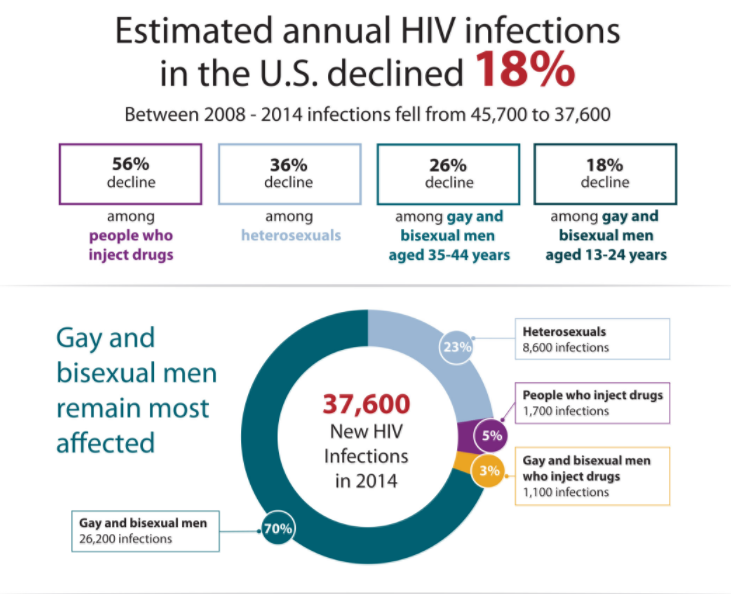
Prevalence
- More than 1.1 million people in the U.S. are living with HIV today, and 1 in 7 of them do not know it.
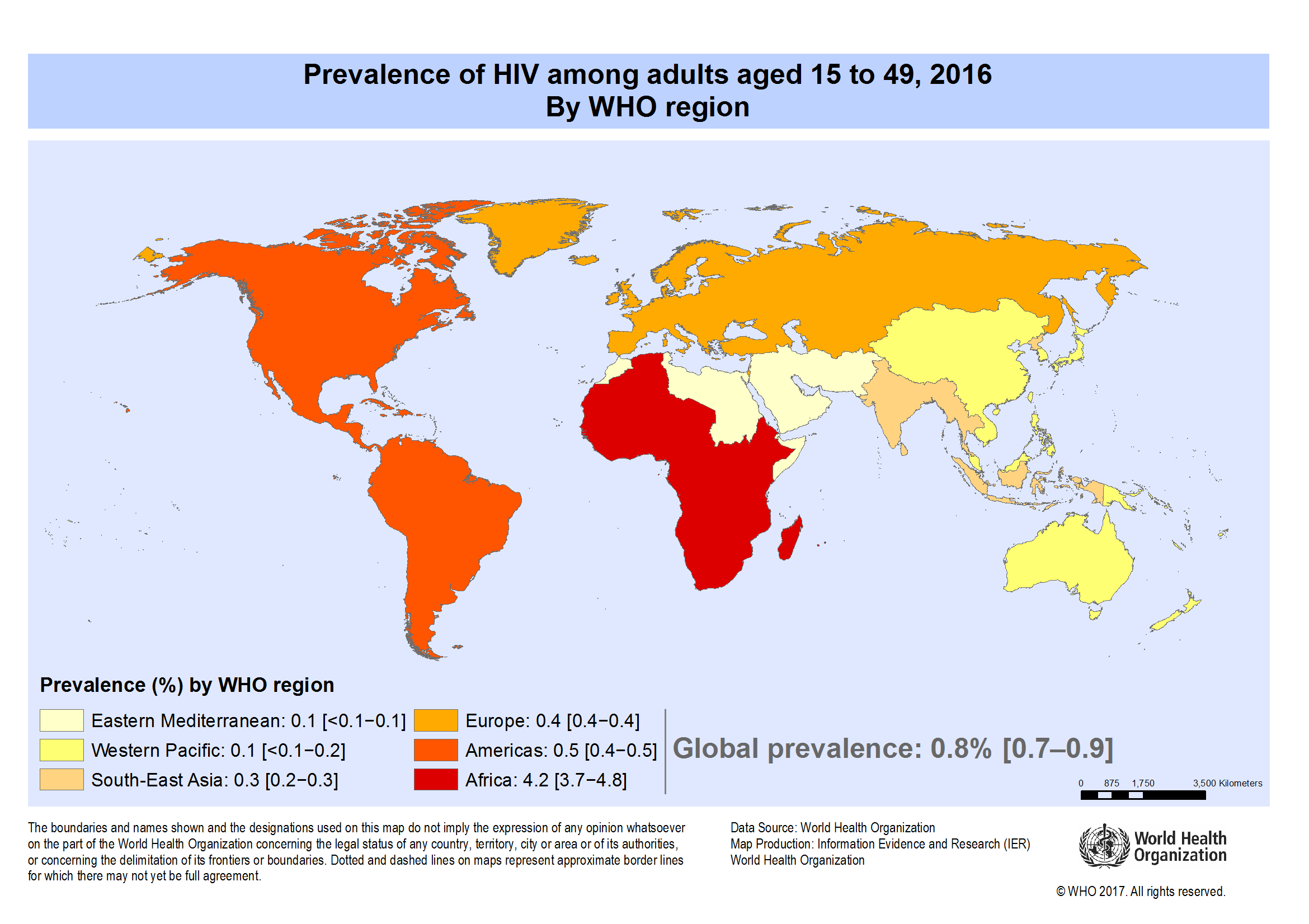
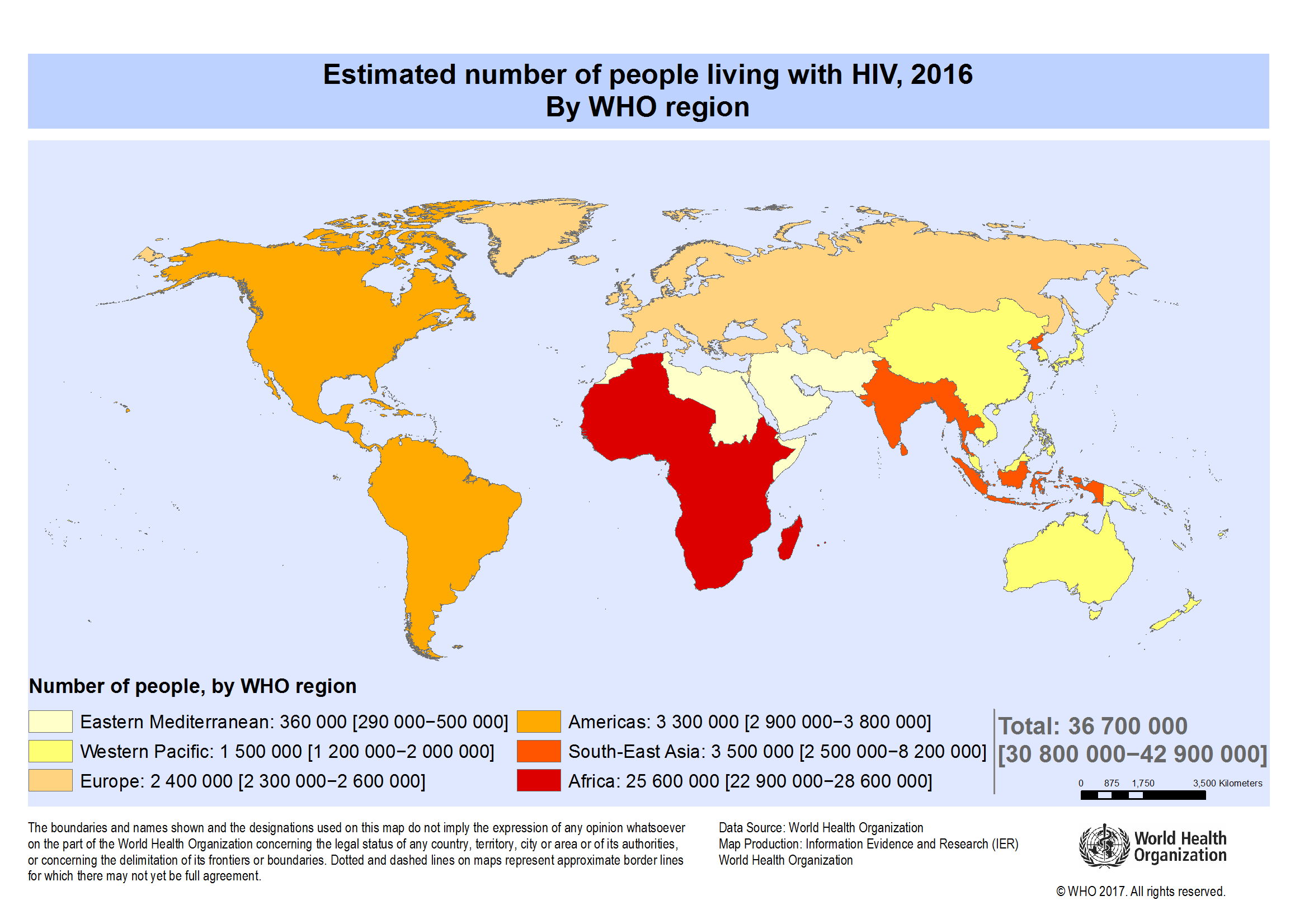
In 2013, the prevalence estimates were as follows:
- Total = 35 million
- Adults = 31.8 million
- Women = 16 million
- Children (<15 years) = 3.2 million
Age
- Globally, an estimated 2.5 million children are living with HIV. An estimated 400,000 children are infected yearly.[6]
The following table demonstrates the estimated number of AIDS diagnoses in the United States in 2011 distributed by age at time of diagnosis:
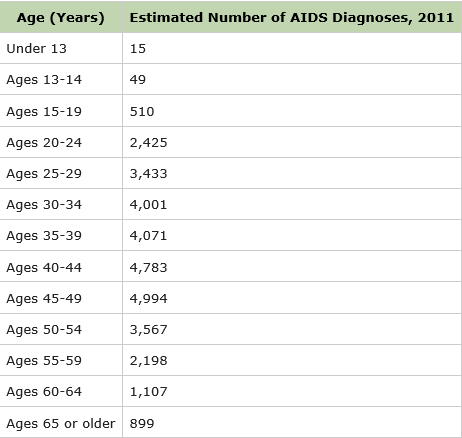
- Owing to the development and success of ART over the past 25 years, the population of individuals with HIV infection is aging.
- For example, in the United States, more than half of the patients receiving care for HIV infection are older than 50 years of age and 18% are older than 60 years.[7]
Gender
In the United States, males are more commonly affected than females. This may be related to the higher prevalence of HIV in homosexual men.
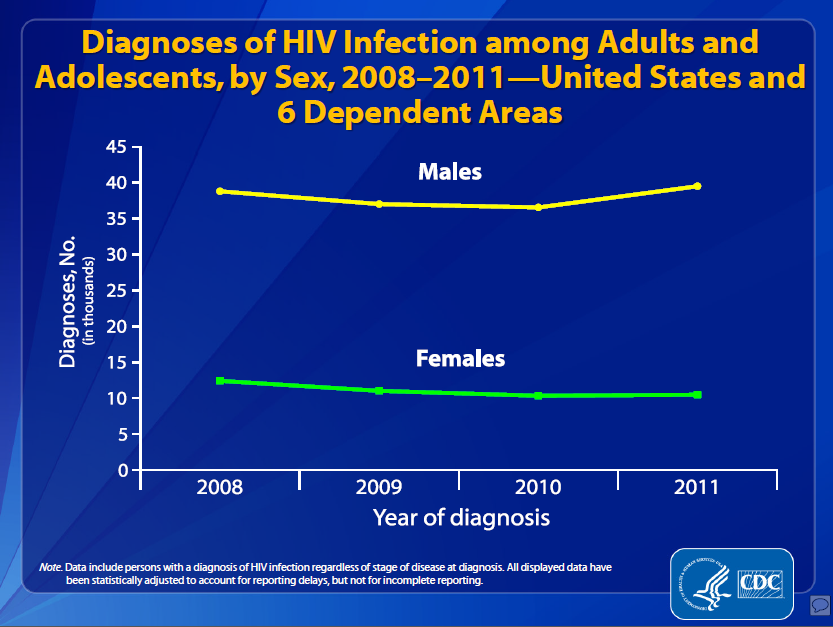
Prevalence by Mode of Transmission
- The most common method of transmission is sexual contact.
- Unprotected male-to-male sexual contact is the major factor, followed by unprotected male-to-female sexual contact.
- In the United States, one out of seven individuals with HIV infection is unaware of having the infection. The HIV transmission from them represents at least one third of new infections each year.
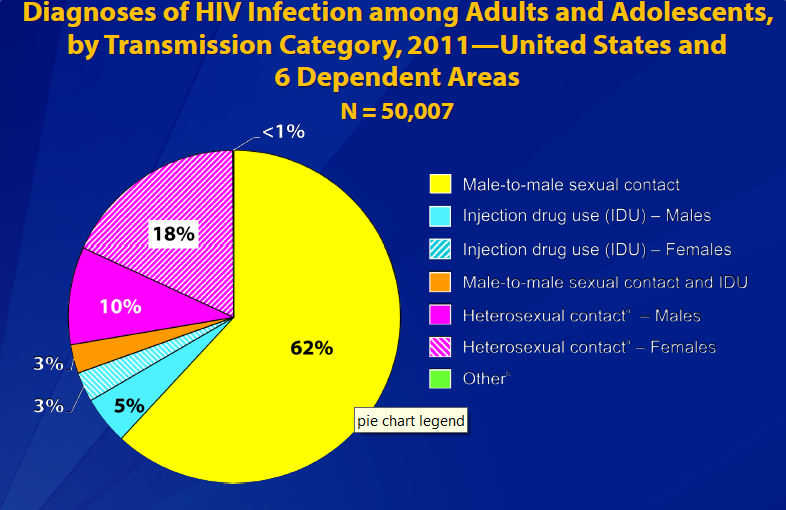
Race/Ethinicity
- HIV type 1 (HIV-1) is the most common and predominant type in the United states; however, HIV type 2 (HIV-2) is endemic in other countries (e.g., West Africa).[8]
- In the United States, HIV is most common among African-American males and females from Native Hawaiian, Hispanic, and Latin origin.
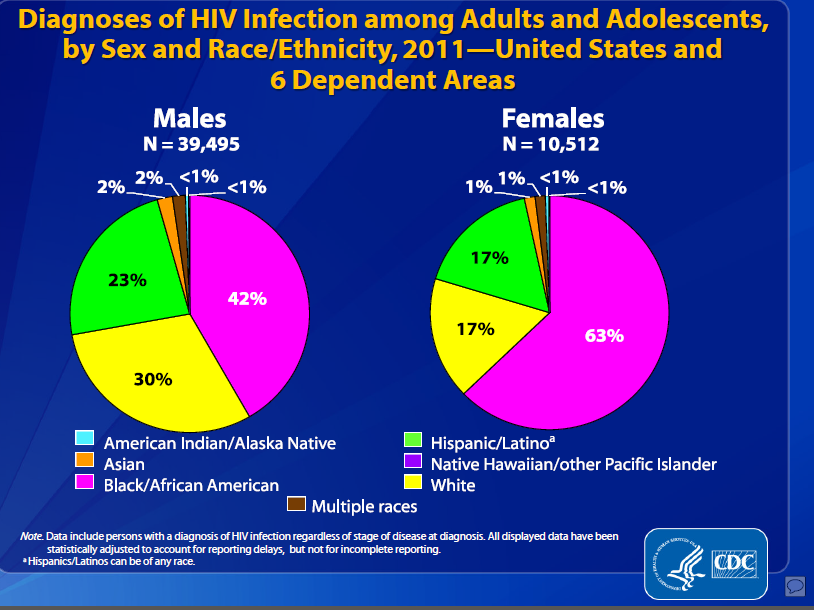
Mortality
- UNAIDS and the WHO estimate that AIDS has killed more than 25 million people since it was first recognized in 1981, making it one of the most destructive epidemics in recorded history.
- The total number of deaths attributable to HIV/AIDS in 2013 according to the WHO:
- Total = 1.5 million
- Adults = 1.3 million
- Children (>15 years) = 190,000
- In 2016, 1.0 million people died from HIV-related causes globally.
- HIV is a major global public health issue and has claimed more than 35 million lives so far.
- Between 2000 and 2016, HIV-related deaths fell by one third with 13.1 million lives saved due to ART.
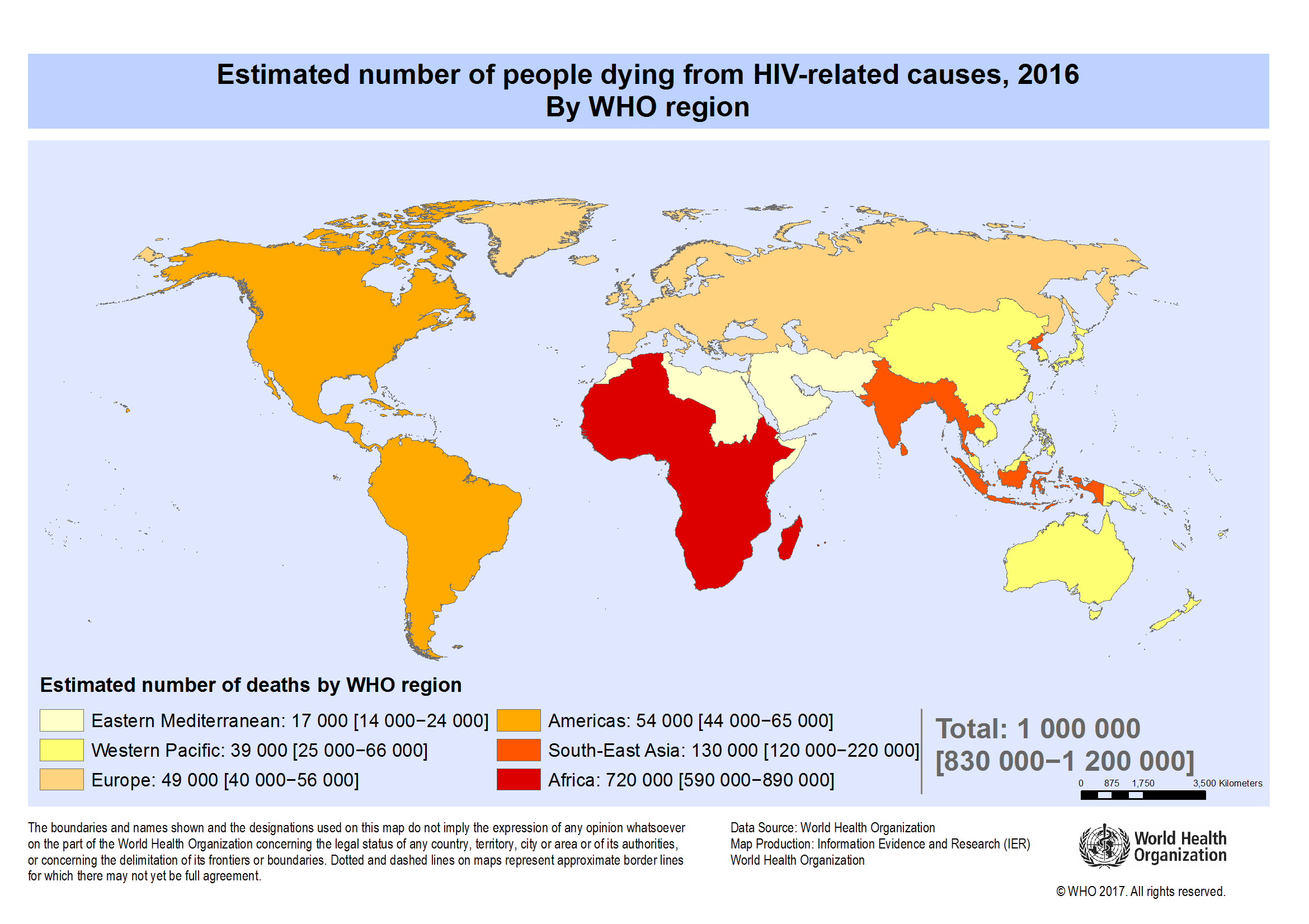
Treatment
- The number of patients receiving antiretroviral therapy has been on the rise since the introduction of these agents.
- In 2013, approximately 12.5 million individuals were receiving antiretroviral therapy.
- Between 2000 and 2016, new HIV infections fell by 39% due to the antiretroviral therapy.
- Between 2000 and 2016, HIV-related deaths fell by one third with 13.1 million lives saved due to ART.
- Global ART coverage for pregnant and breastfeeding women living with HIV is high at 76%.
- In 2016, almost 8 out of 10 pregnant women living with HIV, or 1.1 million women, received antiretrovirals (ARVs).
- In mid-2017, 20.9 million people living with HIV were receiving antiretroviral therapy globally.
- 54% of adults living with HIV are currently receiving lifelong antiretroviral therapy (ART).
- 43% of children living with HIV are currently receiving lifelong antiretroviral therapy (ART).
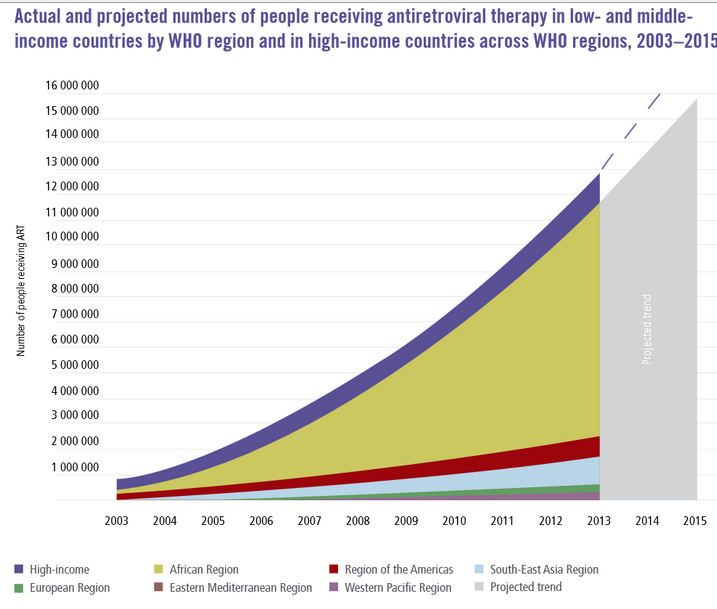
Developing Countries
- Sub-Saharan Africa remains by far the worst affected region, with an estimated 23.8 to 28.9 million people currently living with HIV. More than 60% of all people living with HIV are in Sub-Saharan Africa, as are more than three quarters (76%) of all women living with HIV.
- In 2007, Sub-Saharan Africa accounted for 76% of all AIDS deaths and approximately 35% of all new infections worldwide. Unlike other regions, most people living with HIV in sub-Saharan Africa in 2007 (61%) were women. Adult prevalence in 2007 was an estimated 5.0%, and AIDS continued to be the single largest cause of mortality in this region.[6] South Africa has the largest population of HIV patients in the world, followed by Nigeria and India.[9] South & South East Asia are the second worst affected regions; in 2007, an estimated 18% of all people living with AIDS, and an estimated 300,000 deaths from AIDS were attributable to these regions.[6] The estimated adult prevalence of AIDS in India is approximately 0.36%.[6] Life expectancy has fallen dramatically in the worst-affected countries; for example, in 2006 it was estimated that it had dropped from 65 to 35 years in Botswana.[10]
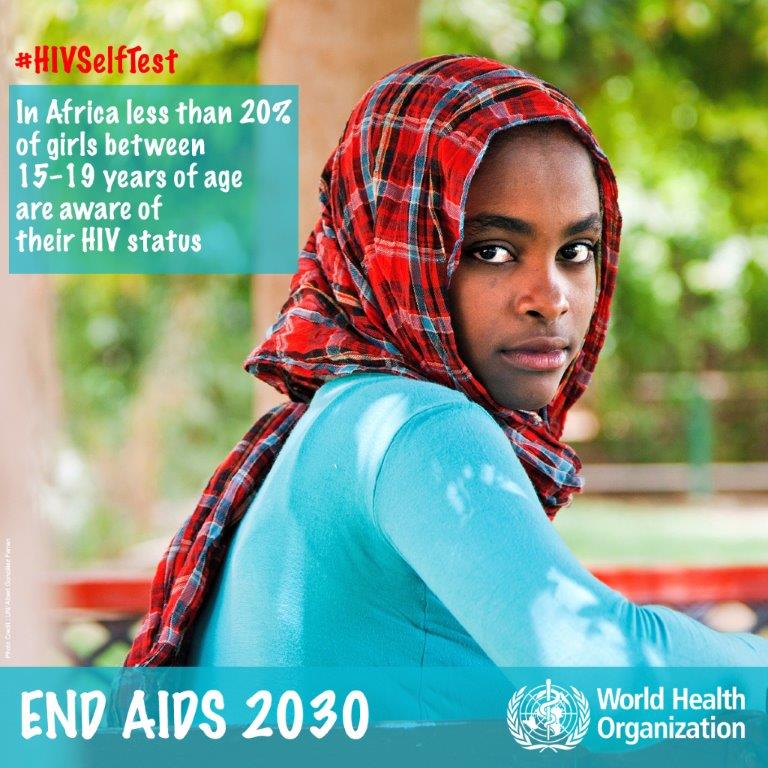
Ending the HIV Epidemic Plan
- This strategy has been adopted by the United States since 2019
- The target is reduction of the number of new HIV infections by 75% by 2025 and by 90% by 2030.
- It includes 4 elements:
- Early identification of all cases of HIV infection
- Successful treatment with ART
- Prevention of new infections
- Rapid response to outbreaks
References
- ↑ {{cite journal | author=Palella FJ Jr, Delaney KM, Moorman AC, et al | title=Declining morbidity and mortality among patients with advanced human immunodeficiency virus infection. HIV Outpatient Study Investigators | journal=N. Engl. J. Med | year=1998 | pages=853–860 | volume=338 | issue=13 | pmid=9516219
- ↑ Centers for Disease Control (CDC) (1982). "Update on acquired immune deficiency syndrome (AIDS)--United States". MMWR Morb Mortal Wkly Rep. 31 (37): 507–8, 513–4. PMID 6815471.
- ↑ Saag MS (2021). "HIV Infection - Screening, Diagnosis, and Treatment". N Engl J Med. 384 (22): 2131–2143. doi:10.1056/NEJMcp1915826. PMID 34077645 Check
|pmid=value (help). - ↑ "WHO 2013 statistics".
- ↑ Peters H, Francis K, Sconza R, Horn A, S Peckham C, Tookey PA; et al. (2017). "UK Mother-to-Child HIV Transmission Rates Continue to Decline: 2012-2014". Clin Infect Dis. 64 (4): 527–528. doi:10.1093/cid/ciw791. PMID 28174911.
- ↑ 6.0 6.1 6.2 6.3 6.4 UNAIDS, WHO (December 2007). "2007 AIDS epidemic update" (PDF). Retrieved 2008-03-12.
- ↑ Marcus JL, Leyden WA, Alexeeff SE, Anderson AN, Hechter RC, Hu H; et al. (2020). "Comparison of Overall and Comorbidity-Free Life Expectancy Between Insured Adults With and Without HIV Infection, 2000-2016". JAMA Netw Open. 3 (6): e207954. doi:10.1001/jamanetworkopen.2020.7954. PMC 7296391 Check
|pmc=value (help). PMID 32539152 Check|pmid=value (help). - ↑ Saag MS (2021). "HIV Infection - Screening, Diagnosis, and Treatment". N Engl J Med. 384 (22): 2131–2143. doi:10.1056/NEJMcp1915826. PMID 34077645 Check
|pmid=value (help). - ↑ McNeil DG Jr (2007-11-20). "U.N. agency to say it overstated extent of H.I.V. cases by millions". New York Times. Retrieved 2008-03-18.
- ↑ Kallings LO (2008). "The first postmodern pandemic: 25 years of HIV/AIDS". J Intern Med. 263 (3): 218–43. doi:10.1111/j.1365-2796.2007.01910.x. PMID 18205765.